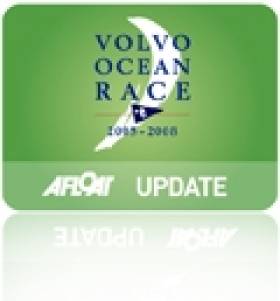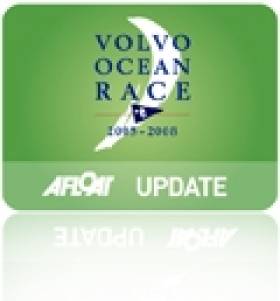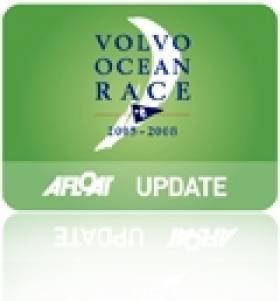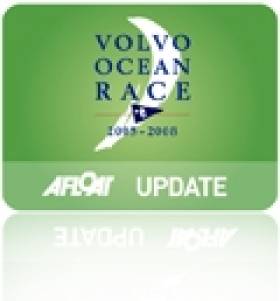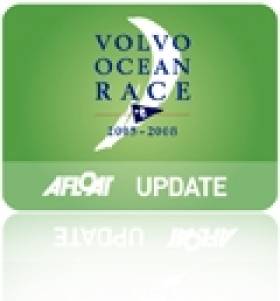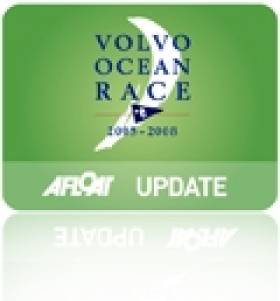Displaying items by tag: Volvo Ocean Race
Sam Davies & Team SCA Seize Volvo Ocean Race Leg 8 Win
#vor – Skipper Sam Davies (GBR) and her Team SCA crew struck a resounding blow for women's offshore sailing in the early hours of Thursday morning when they gloriously clinched Leg 8 of the Volvo Ocean Race.
The comfortable victory was the first leg win in offshore sailing's toughest challenge since Tracy Edwards' Maiden clinched two stage wins in Class D of the 1989-90 race, won overall by Sir Peter Blake's famous Steinlager2.
At least as satisfying for the first all-women's crew to enter the race in 12 years will be the opportunity to silence critics who suggested that they were looking outclassed in the current 12th edition by their experienced male rivals.
True, the Swedish entry had yet to win a podium place until now, but the crew has clearly improved leg after leg and many observers felt that a breakthrough performance was just around the corner.
The win was certainly no fluke in an upwind leg that tested seamanship to the full with an often heinous sea state and strong winds virtually throughout.
They grabbed the 647-nautical mile leg from Lisbon by the scruff of the neck on Monday, and strengthened that grip on Tuesday after taking an offshore course while most of their rivals hugged the Spanish and French coast approaching the Bay of Biscay.
It took them three days 13 hours 11 minutes and 11 seconds to grab their share of Race history.
"Thanks to everybody for all your support. It's not really sunk in yet," said a jubilant Davies. "It probably won't hit us until we hit the dock and we see there aren't any other boats there.
"It's a reward for all the hard work we have done. It's a great confidence booster. It's going to be huge for us. We've had a mountain to climb to get here."
Behind them, another fairy-tale was unfolding as Team Vestas Wind (Chris Nicholson/AUS) closed to a remarkable second-placed finish in their return to the race after six months out following a collision with an Indian Ocean reef on November 29 during Leg 2.
Nicholson had every reason for the huge smile on his face as he approached the port of Lorient following a near perfect race from Lisbon starting on Sunday.
He had simply hoped that his boat could negotiate the leg without mishap and be competitive – a high podium finish is almost beyond his wildest dreams.
"It's a very special moment," said the team's Onboard Reporter, Brian Carlin (IRL), simply.
Astern of the leading pair, third-placed Abu Dhabi Ocean Racing (Ian Walker/GBR) were nearing an ever bigger prize than the handsome silver leg trophy claimed by Team SCA.
They needed simply to finish ahead of their nearest overall pursuers in the standings,Team Brunel (Bouwe Bekking/NED) and Dongfeng Race Team (Charles Caudrelier/FRA), with a boat in between, to be all but be sure of winning the 12th edition of the Volvo Ocean Race.
As Team SCA passed the finish at 0211 UTC/0411 local time on Thursday, that prospect looked very much on with MAPFRE (Xabi Fernández/ESP) in fourth, Team Brunel fifth, and Team Alvimedica (Charlie Enright/USA) keeping Dongfeng Race Team at bay in the fight for sixth.
The boats will have a short maintenance period before Sunday's SCA In-Port Race here in Lorient, before the fleet set sail for Gothenburg via a much-awaited pit-stop in The Hague, on Tuesday, June 16.
It promises to be a period of considerable celebration for at least three crews of very, very happy sailors.
Team SCA PR below:
A sweet victory for Team SCA in Lorient
The culmination of over two years of hard work came together today for Team SCA, as they crossed the finish line after 3 days 13 hours 11 minutes and 11 seconds to take their first leg win of the Volvo Ocean Race in Lorient.
It was an intense 647-mile leg with a bit of everything, from light winds at the start to the brutal upwind conditions in the Bay of Biscay. Conditions that saw several crew members hit hard with seasickness: "Sea sickness has taken its prisoners onboard. Luckily we were prepared for the Bay of Biscay. It has been 24 hours of endless bouncing around upwind. For some onboard it has been 24 hours of hell, a repetitive cycle of drinking, trying to eat, being sick, and trying again [but] the fact that we're winning makes it all the more bearable," commented Annie Lush from on board late last night.
Team SCA led the fleet for more than half the leg and once in pole position, then dominated. A tactical decision to choose the more offshore course as they headed into the Bay of Biscay and forecasted 30 plus knot upwind conditions paid dividends. The fleet split with four boats taking the inshore route, hugging the coastline. For Team SCA it was a case of being the hunted rather than the hunter and holding their position over the others.
The team held their nerve throughout the final hours of Thursday morning to seal a comfortable victory over the fleet.
The performance of the team has been improving leg by leg, winning this leg silences some critics who have felt that all female team could not be competitive in this fleet. "They were up there in performance with the guys but sometimes to do well, you need to sail well. They were just missing a few bits and pieces and on this leg they got it right, and when you get it right, you win," commented Team SCA Coach, Joca Signorini.
Speaking dockside skipper Sam Davies said., "Thanks to everybody for all your support. It's a reward for all the hard work we have done. It's going to be huge for us. We've had a mountain to climb to get here". Sam continued, " The conditions might have been man breaking but they were not women breaking. It feels great to have held that lead in the conditions we had. It was not easy in the Bay of Biscay. But I am proud of how we sailed. It was pretty violent onboard - we had a tough 36 hours across there. If I chose one leg to win it would be this one coming into Lorient, so I am doubly happy".
#VOR - Team SCA have built slightly on their slim advantage ahead of the pack with just 12 to 15 hours of racing left till port in Lorient in the eighth leg of the 2014-15 Volvo Ocean Race.
Currently 10.6 nautical miles clear of their closest rivals in the returning Team Vestas Wind, the all-women squad have put in their strongest performance of the race thus far, notwithstanding their previous in-port race victories.
Yesterday (Tuesday 9 June) they were the first boat to reach the Bay of Biscay to the west of the main pack.
And what makes their current performance all the sweeter are the tough conditions they face in the Atlantic on what's the shortest leg of the round-the-world race.
“It’s blowing a solid 30 knots in four-metre waves, it’s on the edge. We haven’t seen proper upwind sailing like this so far in the race,” said Volvo Ocean Race official meteorologist Gonzalo Infante on yesterday's sea state.
The conditions delayed Team SCA's tack back towards the coast on their approach to Brittany, according to team navigator Libby Greenhaigh.
But any worries have been blown away by just a cursory glance at their current dashboard position – a streak of magenta far ahead of the tight multicoloured pack.
Within that pack, the sailing is at a knife-edge, both between MAPFRE and Team Alvimedica, jockeying for fourth place within half a nautical mile of each other, and the now back-marking Team Brunel and Dongfeng Race Team, almost neck-and-neck with just a 0.2 mile split between their positions.
The latter two - struggling with on-board breakages since yesterday morning that have hampered their progress – are fighting to keep their dreams of overall victory alive as Abu Dhabi Ocean Racing seem set for a comfortable third-place finish, and the all-important points that come with it.
Not that that's come easy for Azzam skipper Ian Walker, who's reportedly barely slept over the past two days.
Meanwhile, back at the front of the fleet, Team SCA are under no illusions that the race is still wide open.
"It is a different position to be leading the fleet and making the first moves or seeing the fleet make a move you chose not to," wrote Greenhaigh, sister of MAPFRE crew member Rob, on the team blog.
“We haven’t been shy to make the first move or a different manouevre before, but when you are leading, it feels like so much more is at stake.”
All-Women's Crew Lead Volvo Ocean Race Fleet on Leg 8
#vor – Team SCA (Sam Davies/GBR) found themselves leading the fleet after a night of thunderstorms and fluctuations as the Volvo Ocean Race Leg 8 entered the first full day in the Atlantic on Monday.
The first all-women's crew to enter offshore sailing's toughest contest for 12 years have improved leg on leg since the start of the race in October last year, but their finishing positions have not reflected that so far.
However, skipper Sam Davies and her team have always eyed the shorter final legs in Europe as their best chance to shine against their male counterparts, and so far on the 647-nautical mile (nm) stage from Lisbon to Lorient, France, they have sailed impeccably.
There is still a long way to go on a leg that is expected to conclude in Brittany in the early hours of Thursday, but the women were certainly enjoying the unaccustomed feeling of being at the head of the competition on Monday.
At the 0645 UTC position report, Team SCA led by 5.5nm from overall race leaders Abu Dhabi Ocean Racing (Ian Walker), having taken the route nearest to the coast of Portugal, where the wind was at its strongest (see panel above).
Overnight leaders Team Vestas Wind (Chris Nicholson/AUS) were caught in a large thunderstorm around 0500 UTC and dropped from first to fifth.
They will be delighted with their progress so far, however, showing good boat speed despite some six months out of the race while their boat was re-built following a collision with a reef in November on Leg 2.
Team Brunel (Bouwe Bekking/NED), who need to beat Abu Dhabi Ocean Racing to close their six-point deficit on them at the head of the standings, were tucked in fourth place while Dongfeng Race Team (Charles Caudrelier/FRA) were last placed, 8nm further astern.
They suffered a small tear in their Code Zero sail when it caught on the spreaders. The crew have successfully repaired it.
The Chinese boat also needs to finish ahead of Azzam to boost their chances of overall victory in the final port of Gothenburg.
#vor – Overall Volvo Ocean Race leaders, Ian Walker (GBR) and his seven Abu Dhabi Ocean Racing crewmates, left Lisbon for Leg 8 to Lorient, France, on Sunday with their eyes glued on the weather forecast - and the progress of their two closest rivals.
The penultimate 647-nautical mile (nm) stage is the shortest of the nine-month race by some way, but no less challenging for that.
Walker summed up: "There are light winds chasing up the Portuguese coast, but by the time we get to Cape Finisterre, it should be a dead beat to Lorient (France), and probably quite windy, over 30 knots."
He is banking on plenty of upwind sailing. "It'll be interesting as we haven't had a lot of upwind in this race. We don't really know what the pecking order is in these conditions, so it could be a very different leg from the others."
The fleet, restored to seven boats again after the return of Team Vestas Wind (Chris Nicholson/AUS) in Lisbon, following the rebuild from the collision with a reef in Leg 2, should take three to four days to reach Lorient on the Brittany coast.
The Emirati boat, on paper, is able to clinch overall victory if results go their way when the boats arrive after around four days of sailing.
The fleet is expected to reach Lorient early on Thursday (June 11). They will have a short maintenance period there before setting off for the final leg to Gothenburg, via a pit-stop in The Hague, on Tuesday, June 16.
Current latest standings (low points wins, In-Port Race Series splits ties):
1. Abu Dhabi Ocean Racing, 16 points
2. Team Brunel (Netherlands), 22
3. Dongfeng Race Team (China), 22
4. Team Alvimedica (Turkey/U.S.), 27
5. MAPFRE (Spain), 27
6. Team SCA (Sweden), 43
7. Team Vestas Wind (Denmark), 52
Position report at: 07 Jun 21:44 UTC
MAPFRE, 664 nm to leg finish
Team Alvimedica, 0.3 nm to leader
Team SCA, 0.6
Dongfeng Race Team, 1.6
Team Brunel, 1.6
Abu Dhabi Ocean Racing, 1.7
Team Vestas Wind, 2.5
#vor – Spanish boat MAPFRE (Iker Martínez/ESP) won their second Volvo Ocean Race in-port race running on Saturday, but only with two metres to spare after a thrilling contest in the Portuguese sun.
Helmed by skipper Iker Martínez, who needed all his feted match-racing skills, MAPFRE edged past Abu Dhabi Ocean Racing (Ian Walker/GBR) in a sprint to the finish line as they gybed together at exactly the same time.
At one stage, it looked as if the Spanish boat would take a penalty for blocking the Emirati boat's path, but former 2004 Olympic champion, Martínez, judged the final manouevre to perfection.
The win, one second ahead, moves the Spaniards back into an outside chance of a podium finish in the series after winning the previous in-port race in Newport, Rhode Island, last month (see scoreboard below).
However, beaten skipper Ian Walker of Abu Dhabi Ocean Racing, will not be disappointed for long. His crew's second place leaves them well clear in the overall in-port standings, with eight of the 10 races completed.
Their closest rivals, Team Brunel (Bouwe Bekking/NED), struggled for much of the course, which was cut from six to five legs by the Race Committee, due to decreasing winds on the tidal Tagus River.
For so long, MAPFRE had looked to have the race safely in their pockets.
Team SCA (Sam Davies/GBR) led the seven-strong fleet across the line, only to be penalised for starting too early (OCS - on course side).
The unlucky all-women's crew, who later battled back heroically to take fourth place, were forced to turn back against the tide to re-cross the line, losing dozens of metres to their rivals.
From then, MAPFRE looked in complete control, taking a 400-metre lead at the third mark, but just when it appeared to be a done deal, Abu Dhabi Ocean Racing stormed back in stronger wind on Leg 4 and briefly snatched the lead from them.
Undaunted, Martínez slipped his boat across the Emirati yacht in a grandstand finish to take the gun.
Team Alvimedica (Charlie Enright/USA), who, pre-race, had trained in nearby Cascais, used their local knowledge for a solid third-place podium spot, but the drama was by no means over.
Team SCA and Team Vestas Wind (Chris Nicholson/AUS) had a near copy of the MAPFRE/Abu Dhabi Ocean Racing showdown, both approaching the finish within metres of each other.
Vestas Wind, however, was then, unfortunately, snagged on the finish mark and forced to complete a turn and re-cross the line allowing Team Brunel and a disappointed Dongfeng Race Team (Charles Caudrelier/FRA) to pass and leave them trailing in the seventh and final position.
Team Vestas Wind, whose crew member Nicolai Sehested (DEN) was left stranded on the mark as he tried to free the boat, were returning after a six-month absence from the race having grounded on an Indian Ocean reef during Leg 2, necessitating a complete boat rebuild.
Sunday (1400 local time/1300 UTC) will see the start of Leg 8, a 647-nautical mile stage to Lorient. Abu Dhabi Ocean Racing begin with a six-point overall advantage over both Team Brunel and Dongfeng Race Team.
Lisbon In-Port Race results
1. MAPFRE 14:59:39 - 1pt
2. Abu Dhabi Ocean Racing 14:59:40 - 2pts
3. Team Alvimedica 15:05:07 - 3pts
4. Team SCA 15:08:38 - 4pts
5. Team Brunel 15:09:44 - 5pts
6. Dongfeng Race Team 15:13:07 - 6pts
7. Team Vestas Wind 15:15:14 - 7pts
In-Port Race Overall standings
1. Abu Dhabi Ocean Racing - 21pts
2. Team Brunel - 25pts
3. Team SCA - 28pts
4. Team Alvimedica – 31pts
5. MAPFRE - 32pts
6. Dongfeng Race Team- 33pts
7. Team Vestas Wind - 59pts
Volvo Ocean Race Enters Final Two Legs
#vor – An independent ISAF jury's decision to impose a penalty point on Abu Dhabi Ocean Racing's closest rivals for the Volvo Ocean Race 2014-15 title could, paradoxically, leave Ian Walker's crew with an unwanted headache for the final two legs.
The Emirati boat's skipper had previously conceded that his tactics for the closing legs, having opened up a formidable six-point advantage, would be to 'cover' Dongfeng Race Team (Charles Caudrelier/FRA).
Anyone thinking that Walker and co will consequently sleep that much better on the eve of Sunday's (June 7) Leg 8 departure, may have pause for thought, however.
The Briton will no longer have just one boat to 'cover'.
He needs to keep a very close eye on both Team Brunel and Dongfeng Race Team and with Team Vestas Wind (Chris Nicholson/AUS) now back in a restored seven-strong fleet, there are several permutations that could yet see Abu Dhabi Ocean Racing miss out on the grand prize.
Walker sees things pretty simply: "We've got to finish in the top three or top four - twice - or just beat them (Team Brunel and Dongfeng Race Team)," he said.
#VOR - Team Vestas Wind have passed their biggest test yet in their quest to rejoin the Volvo Ocean Race in time for the eighth leg from Lisbon to Lorient.
As Jonno Turner writes for the official VOR website, crowds lined the waterfront at the Lisbon Race Village yesterday (Saturday 30 May) to see the team take their rebuilt yacht on the water for the first time since running aground in the Indian Ocean last November.
“It’s a massive hurdle to have overcome. It’s something we don’t have to think back to anymore, it’s about enjoying the future," said shore manager Neil Cox.
And what that future holds is shaking up what's been a highly competitive six-boat race since the start of the year. Here's looking forward to Irish journalist Brian Carlin's onboard reports.
#vor – Team Brunel (Bouwe Bekking/NED) completed a triumphant Leg 7 early on Wednesday to bolster their hopes of finishing with a podium place in the Volvo Ocean Race and also keep alive the possibility of overall victory.
The Dutch boat sailed a near faultless transatlantic stage, edging MAPFRE (Iker Martínez/ESP) into second, just under 22 minutes behind.
Behind them, Dongfeng Race Team (Charles Caudrelier/FRA), Team Alvimedica (Charlie Enright/USA) and overall leaders Abu Dhabi Ocean Racing (Ian Walker/GBR) were playing hunt the breeze in a three-way tussle for the final podium place.
If Abu Dhabi Ocean Racing finish fifth that could open the door again for Team Brunel, currently third overall, who would move within six points of the Emirati boat.
Team SCA (Sam Davies/GBR) were just a handful of miles further astern.
Few sailors in the fleet will savour a win over one of the race's trademark legs more than Team Brunel's 51-year-old skipper, Bouwe Bekking, in his record-equalling seventh appearance.
He has certainly experienced the ups and downs of sailing the Atlantic. Few will forget the agonising position he faced in 2006 before he was finally forced to abandon his sinking movistar boat during the same stage of that Volvo Ocean Race.
Bekking insisted last week that he had not lost 'a single night's sleep' over the incident and the confident way that Team Brunel sailed the leg would bear that out.
Team Brunel were harried all the way over the past 24 hours by both MAPFRE and Dongfeng Race Team, especially over the final few miles in a 'park-up' in the Tagus River as they approached the Lisbon finish.
"We sailed a tremendous leg but just at the end when there was no wind, it was getting a bit gnarly," said Bekkiing. "But we pulled it off."
The victory was achieved with two newcomers on board, Adam Minoprio (NZL) and Timo Hagoort (NED), the latter replacing the injured Gerd-Jan Poortman (NED).
"It was good to have those young guys on board, they did a fantastic job," added Bekking.
The final two stages, to Lorient (France) and then Gothenburg (Sweden) via a pit-stop in The Hague (Netherlands), will once again be contested by seven boats.
Team Vestas Wind (Chris Nicholson/AUS) rejoin the fleet for the first time since November 29 when the boat was grounded on a reef in the Indian Ocean.
After a four-month rebuild in the Persico boatyard in Bergamo, Italy, the boat was transported by sea and road to Lisbon, arriving a few hours before the rest of the fleet in the small hours of Wednesday morning.
Over the next few days, the rig will be stepped ahead of the Danish-backed team's competitive comeback on June 6 in the Lisbon In-Port Race. Leg 8 to Lorient, a relative sprint at 647nm, begins a day later.
The race concludes on June 27 with the In-Port Race in Gothenburg after nine months and 38,739nm of sailing, visiting 11 ports and every continent.
#VOR - Almost seven days into Leg 7 of the 2014-15 Volvo Ocean Race and there's finally been a split in the fleet, as Team SCA paid for mistakes along the Atlantic exclusion zone earlier in the week.
"The rest of the fleet is closer to the centre of the high pressure from the Azores," writes the all-women team's onboard reporter Anna-Lena Elled.
"The first boat out on the other side will get the new pressure and take off like a bullet for the finish line. We have to come up with something different."
That difference could be speed: catching higher pressure on the outside to make up their lost ground and nip at the heels of the leaders some 38 nautical miles ahead.
And with their current speed 25% faster than the top two teams, and with 9.4nm gained in the last few hours of this morning (Sunday 27 May), that plan appears to be paying off – but only three days of racing lie ahead before Lisbon.
Elsewhere, in the main pack there are two races going on: for the current leg, which as of this morning has Team Brunel in the narrow lead, just half a mile clear of MAPFRE, with Dongfeng Race Team another mile behind; and between Dongfeng and Abu Dhabi Ocean Racing, separated by just six points in the overall standings.
With Abu Dhabi currently behind the top three boats by 12nm – and Team Alvimedica between them – the next three days will be crucial to secure the best position for points.
Key to doing that in this incredibly tight and short leg is "the favourite Volvo Ocean Race game this time round", as Dongfeng skipper Charles Caudrelier describes the AIS tracking system.
Designed with safety at sea in mind, AIS is now integral to VOR race strategy, as it allows boats to determine the speed and direction of vessels within 20nm – meaning reactions to other teams' moves can be much more than an educated guess.
"By the end of the race I will have without doubt spent more time in front of this game than on deck, and certainly more than at the helm," says Caudrelier.
Things will only get more complicated to manage when Team Vestas Wind rejoin the fleet at Lisbon – their yacht now fully repaired and headed from the Persico boatyard in Italy to Portugal by road in time for the fleet's arrival in port.
But back to the race at hand, and a leg win for Brunel would be sweet relief for skipper Bouwe Bekking, who this week passed the point where nine years ago to the day his then boat movistar was swamped by the Atlantic, forcing him to abandon ship.
#VOR - Spanish team MAPFRE celebrated their first in-port series win of the 2014-15 Volvo Ocean Race in Newpor, Rhode Island yesterday (Saturday 16 May) in a contest notably title-sponsored by the absent Team Vestas Wind.
And as the official VOR website reports, no other boat really had a look-in, as Iker Martínez's yacht and crew secured an early lead -opting for the left gate at the first mark and benefiting from the extra pressure available on that side of the course.
While the victory hasn't changed MAPFRE's lowly sixth place on the leaderboard, it did close the gap between them and Team Alvimedica – now just three points apart – as the race enters its crucial shorter homeward legs.
The first of these sets sail in a little over eight hours time, as the six-boat fleet heads across the Atlantic to Lisbon - and a date with the rejoining Team Vestas Wind.



























